by Ilaria Baratta , published on 31/05/2020
Categories: Works and artists
/ Disclaimer
In Bomarzo, in the mid-16th century, a nobleman, Pier Francesco Orsini, decided to shape an incredible initiatory journey among bizarre wonders: this is the Sacred Wood of Bomarzo, one of the most extraordinary places in our country.
“Tu ch’entri qua pon mente parte a parte e dimmi poi se tante meraviglie sien fatte per inganno o pur per arte,” sentences one sphinx, and the other: “Chi con ciglia inarcate et labra stretto non va per questo loco manco ammira le famose del mondo moli sette,” or the seven wonders of the world. Both welcome with these words anyone who enters and begins to walk through one of Italy’s most evocative parks, the Sacred Wood of Bomarzo, for here nature and art meet, or rather, wonders that enchant the visitor in anescalation of strange and majestic figures. In fact, as one of the sphinxes at the park’s entrance suggests, it is impossible to walk its paths and penetrate the lush vegetation without stopping, eyes wide with wonder and mouths emitting an expression of surprise, every time one encounters one of the sculptures scattered along the entire route. That is, every little bit, because the monumental statues are indeed many, and each one responds with great variety and imagination to the inevitable need to surprise. Probably the intent of the commissioner Pier Francesco Orsini, known as Vicino (Rome, 1523 - Bomarzo, 1585), was just that, although the meaning behind the entire path remains unknown to this day: to create a place of wonder, in which, once you enter, you let yourself abandon yourself without thinking about anything anymore, leaving your mind free to be enchanted transported to a world uniquely made up of fantastic creatures and strange buildings. All immersed in dense vegetation that contributes to the perception of being enclosed in a magical place, foreign to reality. It is no coincidence that the central focus of the entire mind-releasing journey is the face of a large ogre who presents himself to visitors with wide-open eyes, flaring nostrils and a gaping mouth from which two sharp teeth sprout, and on whose upper lip is engraved the inscription “Every thought flies.” the frightening ogre (in the collective imagination, a giant monster characterized by a huge mouth, since it used to feed on humans, especially children) shows the large mouth open as if to greedily swallow someone, but at the same time invites one to enter, climbing a series of steps, to be totally free of all thoughts.
The inscription on an obelisk “Sol per sfogare il core” could refer to the untimely death of Vicino’s beloved wife Giulia Farnese in 1560, thus reading the entire park as a place aimed only at finding serenity, leaving out grief. In fact, the project of building the garden had begun long before, around the 1940s, and had been referred to simply as a “grove” while his consort was still alive, but it seems that he completed and redefined it after Giulia’s passing, dedicating it to her.
According to art critic Maurizio Calvesi, the Sacred Grove was completed in at least three phases, but the two obelisks and the leaning house, the latter an extraordinary example of a construction with an irregular slope that causes bewilderment once one enters, were completed earlier: perhaps the house around the mid-1650s, when Orsini was busy with his military career and had been taken prisoner, and on one of the obelisks is written “Vicino Orsino in MDLII.” The leaning house is said to have been built by the woman following the failure of Vicino’s military mission: in fact, the Orsini coat of arms and the inscription “Animus quiescendo fit prudentior ergo” (“Try to appease yourself in this dwelling”), a dedication to Cardinal Madruzzo who interceded to free him, can be seen in it.
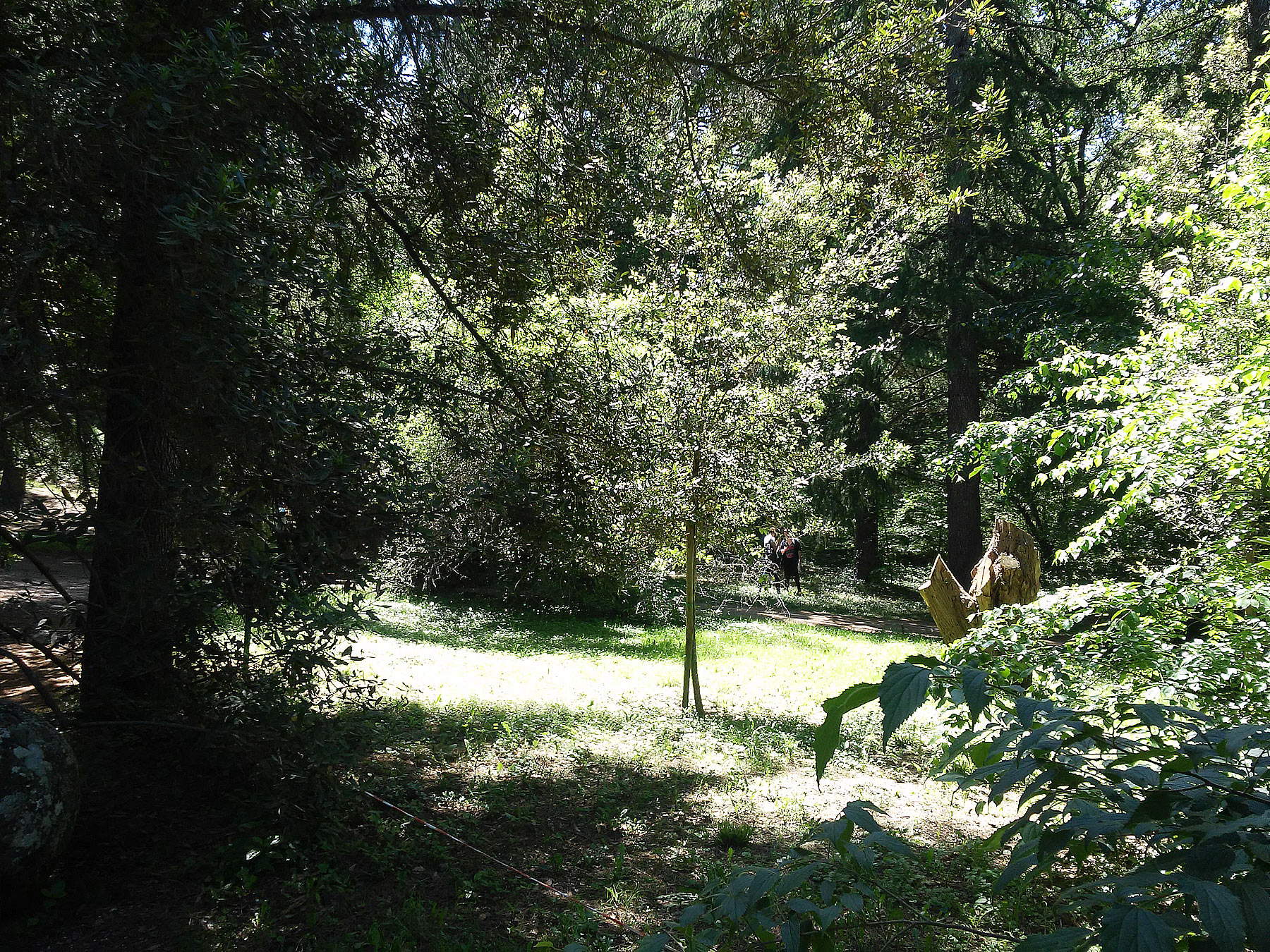 |
| The Wood of Bomarzo |
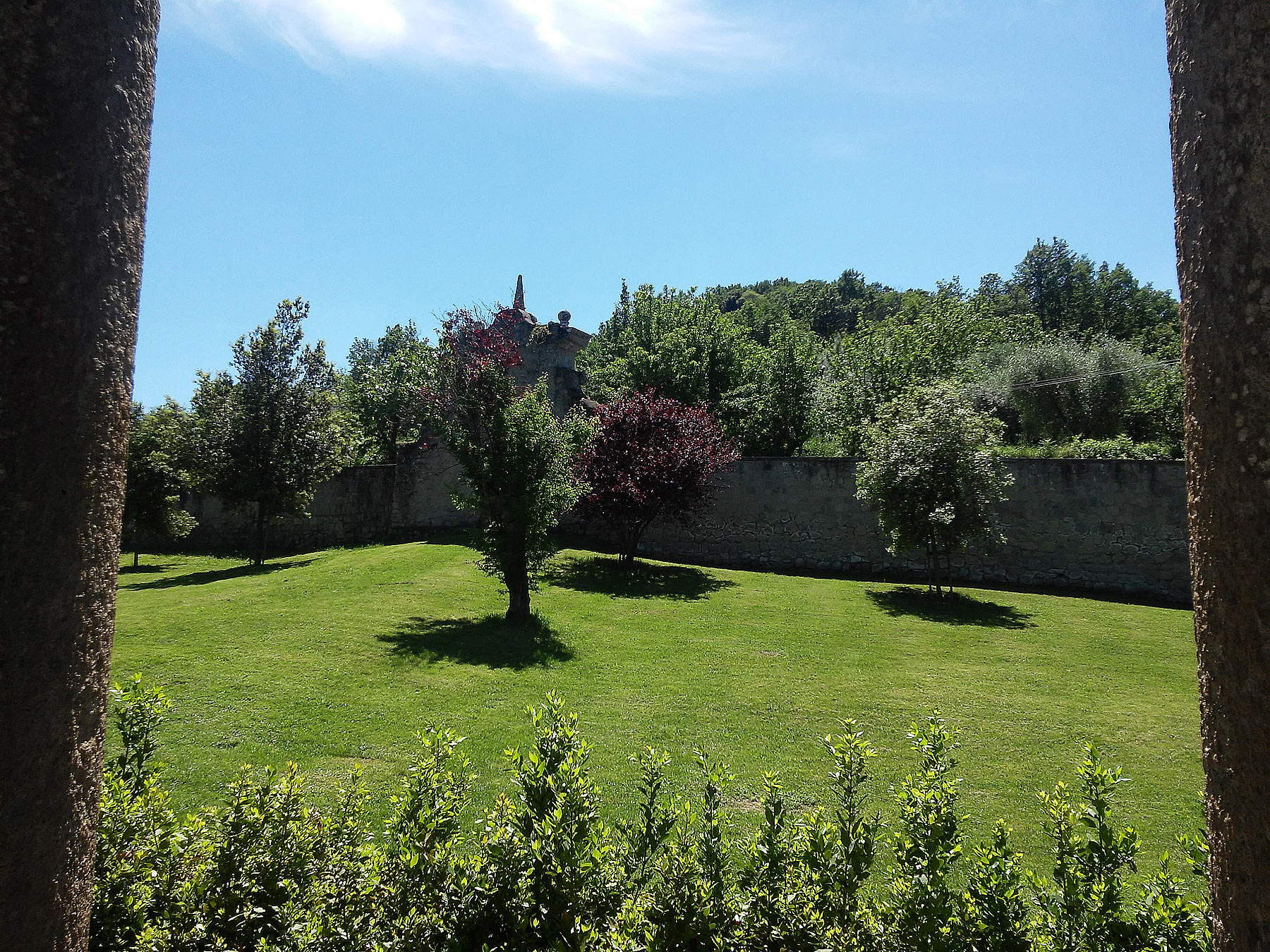 |
| The Wood of Bomarzo |
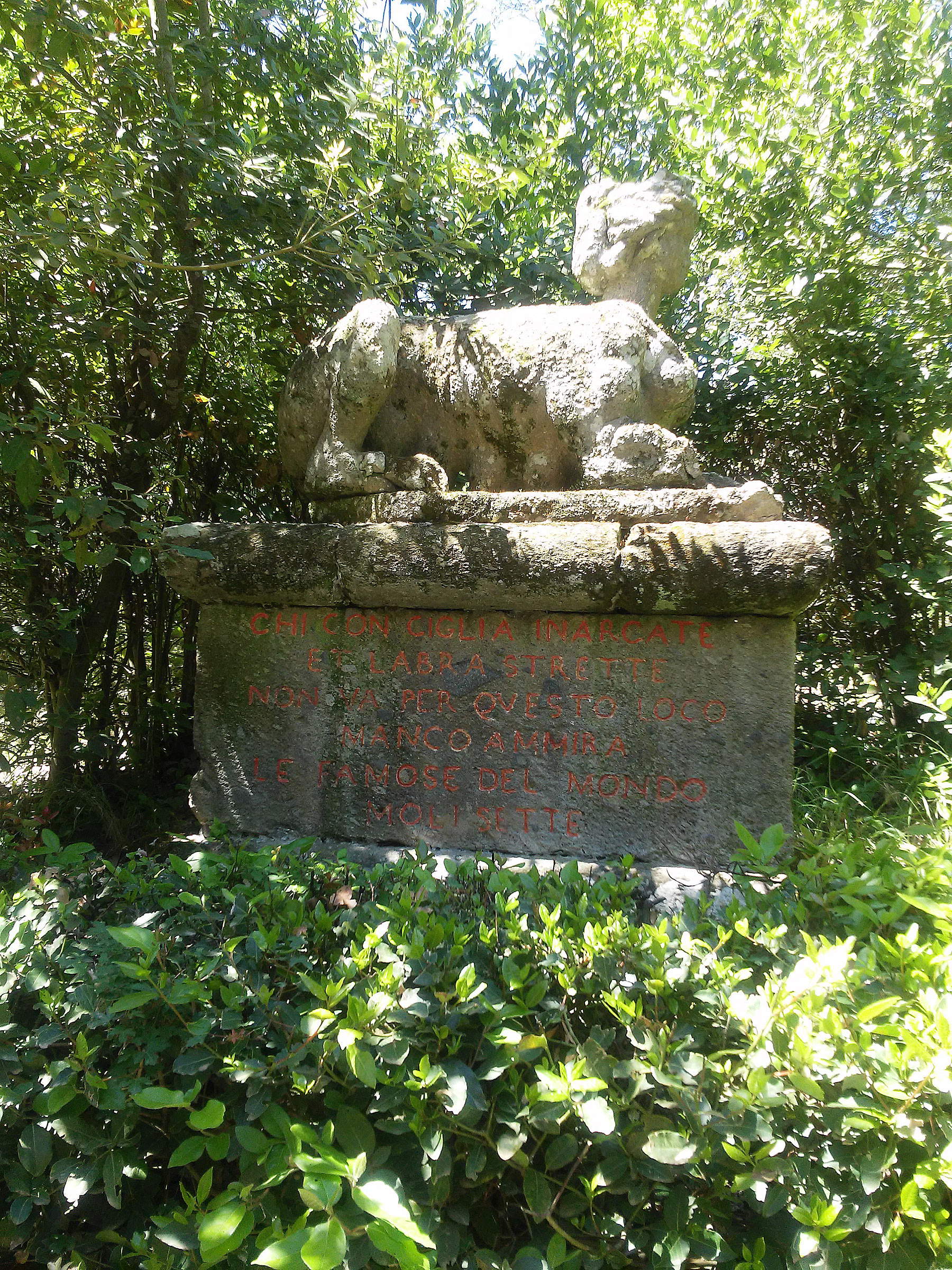 |
| The sphinx on the left |
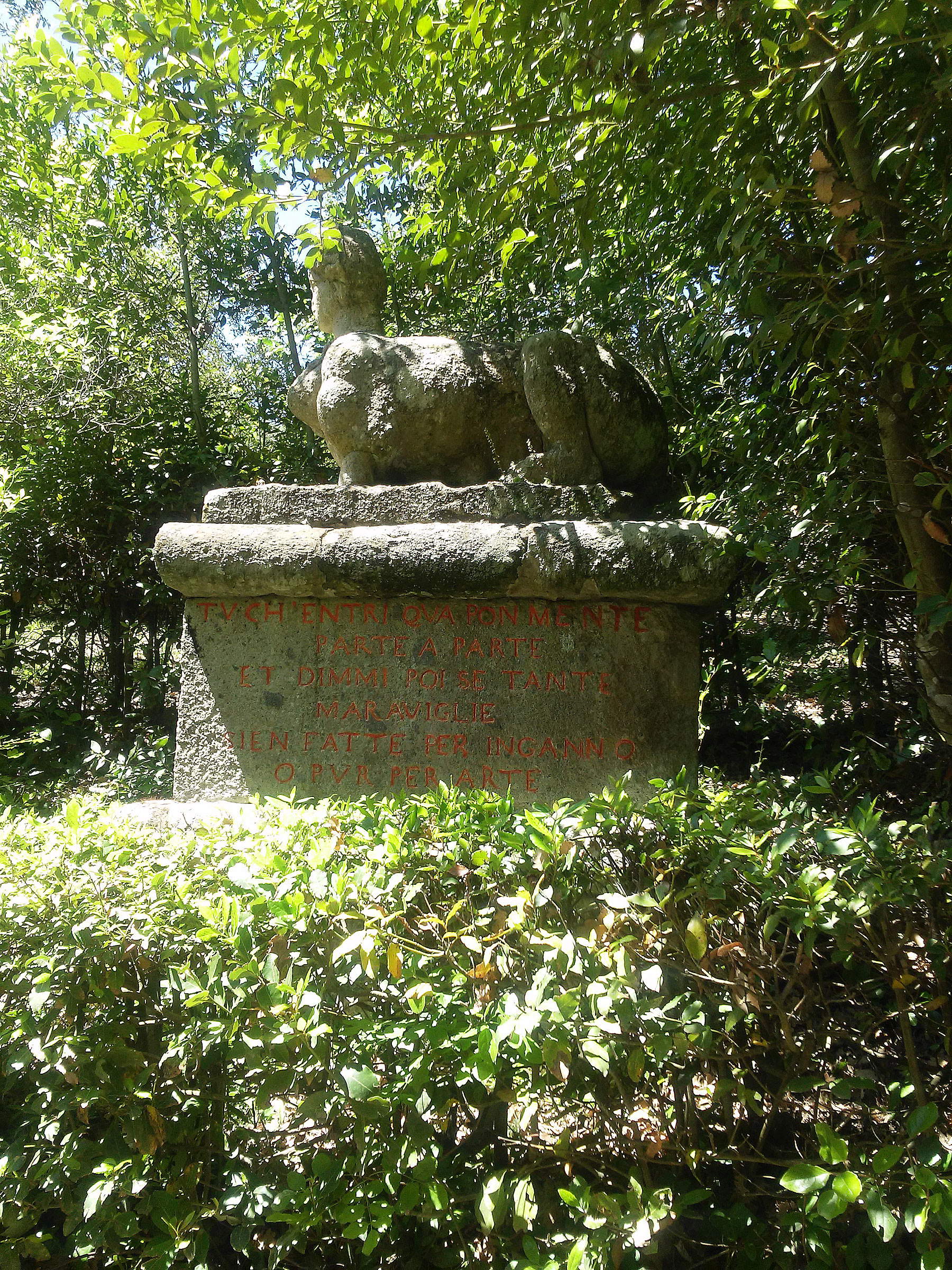 |
| The sphinx on the right |
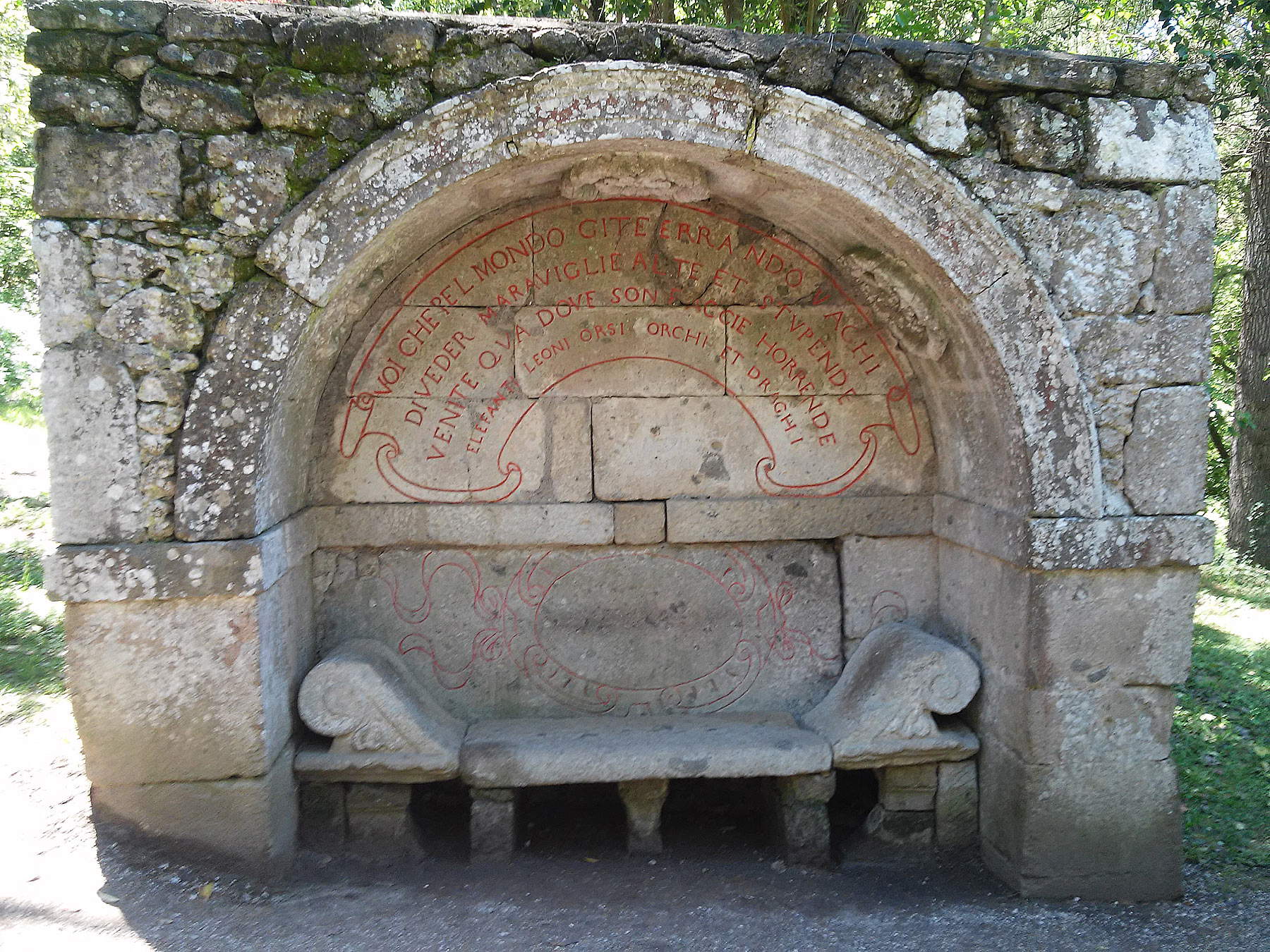 |
| The Etruscan bench |
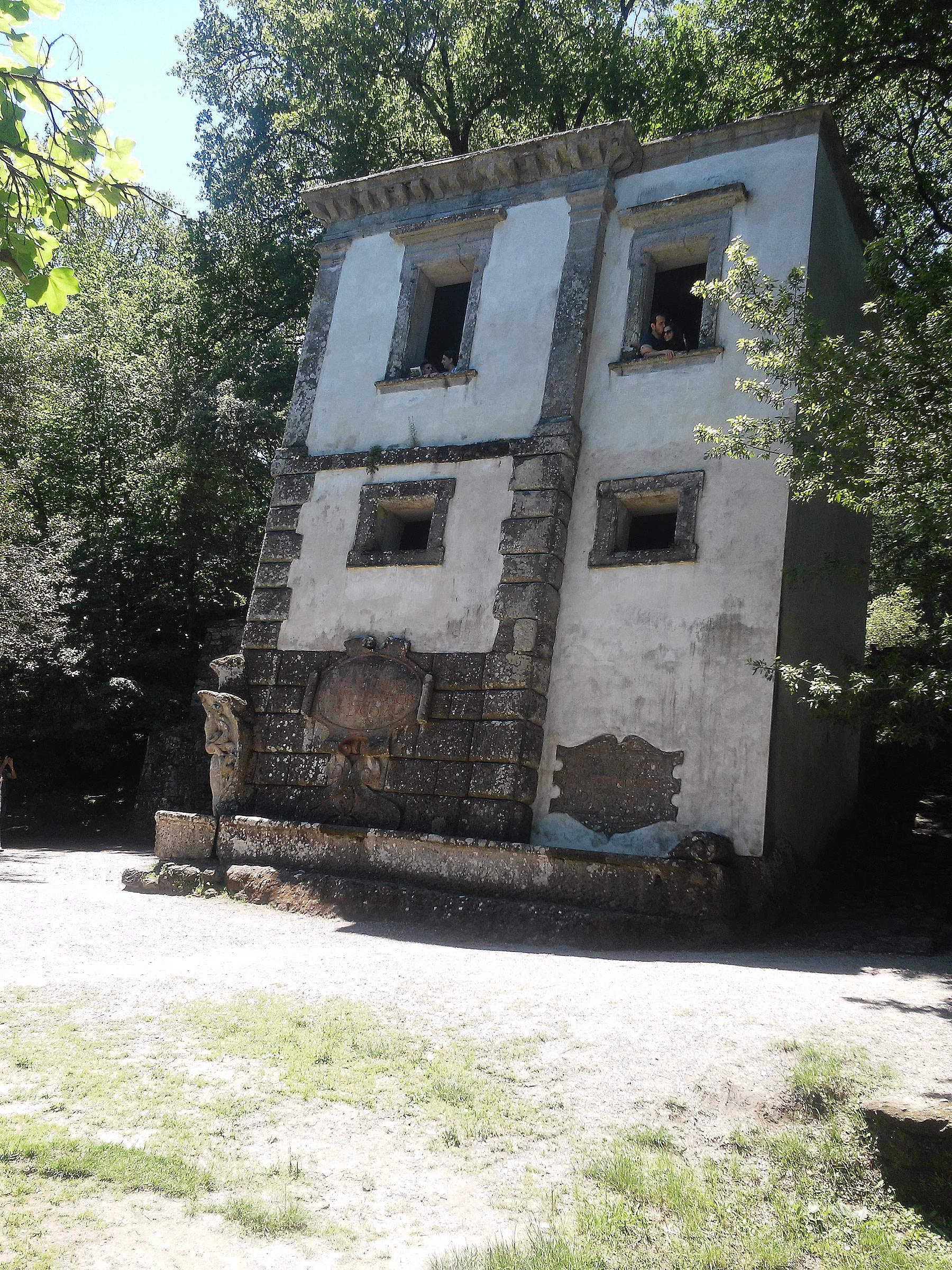 |
| The leaning house |
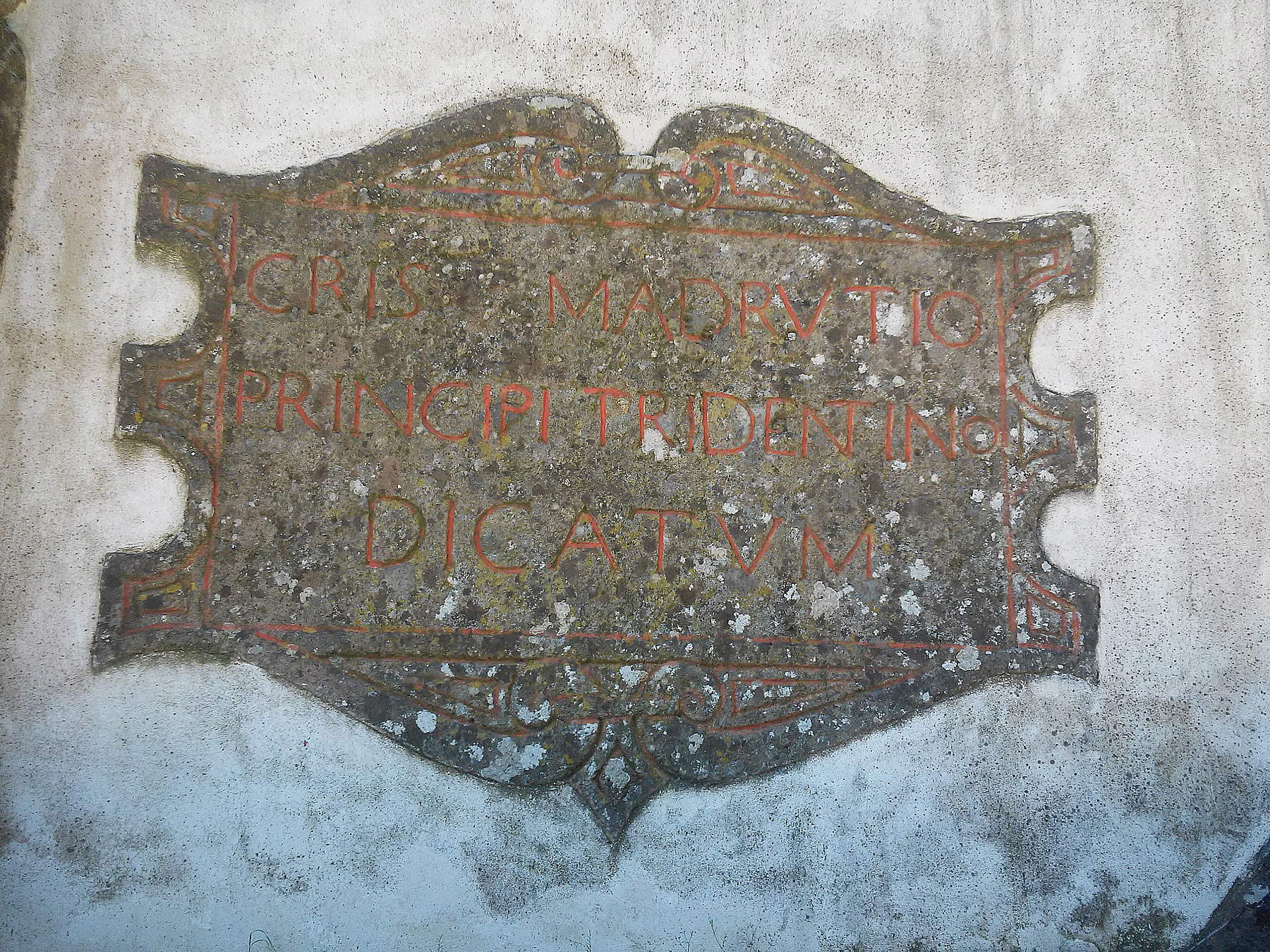 |
| The dedication to Cardinal Madruzzo |
Regarding the above-mentioned inscription “Sol per sfogare il core,” a connection was seen instead with a line from a poem by Vittoria Colonna, which reads “Scrivo sol per sfogar l’interna doglia/di che si pasce il cor”, or with sonnet CCXCIIII of Petrarch ’s Canzoniere (“E certo ogni mio studio in quel tempo era / pur d’isfogare il doloroso core / in qualche modo, non d’acquistar fama”).
Vicino Orsini was the son of a condottiere in the feudal lordship of Bomarzo, and he often resided here, since his father had had the baronial palace erected there, not far from Viterbo.
It was precisely in Viterbo, around 1540, that the comedy La Cangiaria had been performed, which tells of a herma that causes metamorphoses in the characters: this probably influenced the project of making the statues that Vicino thought of having placed along the paths of the famous park. One of the gentleman’s passions was literature , and he often attended the literary meetings held at Cardinal Alessandro Farnese’s, where he had the opportunity to increase his intellectual education and come into contact with Annibal Caro, among the leading literary men of the circle, with whom he formed a strong friendship. His relationship with the Farnese branch was consolidated with his union to Giulia Farnese, whom he married in 1544. In addition, Ottavio Farnese sent him two years later on the papal expedition to Germany, and there, along with Cardinal Farnese as apostolic legate, was Cardinal Madruzzo, to whom Orsini remained close. On his return to Bomarzo in 1547, he found erected the church of Santa Maria della Valle that his wife Giulia had had built in his absence. Among the expeditions in which he took part for the Farnese, the one in Flanders on the side of the French troops is particularly noteworthy, for the battle of Hesdin was won by the Imperials and Vicino was taken prisoner: this was in 1553 and he was freed two years later, in 1555. It was during this period, as previously mentioned, that Julia probably had the leaning house built. After several battles with disappointing outcomes and the untimely death of his beloved wife, he no longer took part in military actions, but was nevertheless celebrated as a good leader, as he was considered, in the poem Amadigi di Gaula by Bernardo Tasso (Venice, 1493 - Ostiglia, 1569), written in 1560. He then retired to his Bomarzo, where inspired by literary influences he planned the final completion of the Sacred Wood: although the beginning of work on the garden is traced back to 1552 only to be interrupted as a result of military activity, it was in fact from 1560 that the project took shape, thanks to the architect Pirro Ligorio (Naples, 1513 - Ferrara, 1583), one of the greatest Mannerist architects. We have testimony from Annibal Caro, in two letters of 1564, that work on the park resumed with the creation of new works, such as the small temple at the end of the path, the fountains and their loggia, the sphinxes, and the enormous statues. In a succession of new ideas and creations, without interruption, the project continued until the death of Vicinus. Large figures of monsters, animals, and mythological characters were carved into the peperino and basalt boulders that emerged from the ground, making the park still today a significant example of a Baroque garden, a far cry from the typical Italian and Renaissance gardens where everything had a regular and symmetrical shape. Vicino Orsini and Pirro Ligorio gave life, on the contrary, to a forest unique in its irregularity, in the sensation of the marvelous and magical that it made people feel and in the general iconography that is still enigmatic.
The structure of the Park of Bomarzo, at the foot of Mount Cimino, suggested an initiatory path to be taken starting from the lowest point, that is, from the entrance where the sphinxes are located, to the highest point, where the small temple is located. The presence of the sphinxes, on which inscriptions have also been affixed, at the very entrance to the path is indeed reminiscent of the famous enigma of the Sphinx that was addressed to passers-by at the entrance to the city of Thebes; the sphinx, however, is a mythological figure closely associated with mystery and indecipherability, just as indecipherable is still the overall meaning of the park. While the temple, generally located at the top, may signify the achievement of a goal, in this case probably of an inner journey.
Starting from the Sphinxes one encounters, as the inscription on the Etruscan Bench states, “faces horrende, elephants, lions, orcs et dragons,” and the invitation to come to the Monster Park is addressed to “Voi che pel mondo gite errando vaghi di veder meraviglie alte et stupende.” First we come face to face with Proteus-Glaucus, an aquatic being from Greek mythology associated with his ability to change form. He holds on his head a globe that appears to rotate, above which stands the model of a castle. Two giants, Hercules and Cacus, then wrestle before our eyes with the obvious and well-known victory of the former over the latter. According to some written accounts, Vicino Orsini had a certain interest in giants, so much so that he would have liked to have his palace in Bomarzo decorated with the Gigantomachia, probably inspired by Giulio Romano ’s masterpiece that can be admired in Palazzo Te in Mantua, the Hall of Giants. In addition, Cardinal Madruzzo had begun collecting “bones of giants,” possibly belonging to prehistoric animals. In a space slightly below, descending from stone stairs, one reaches a particular group consisting of an enormous tortoise, above whose carapace is the figure of a woman standing on a globe, a Nike or Winged Victory. Among the turtle’s symbolisms, such as wisdom and power, is its attachment to the earth: the land animal stares at a wide-mouthed whale sprouting from the moat in front of the turtle. Orsini designed the movement of the water around the whale to highlight a danger from which to protect himself: an image that harked back to the illustration in a 1563 edition of Ariosto’sOrlando Furioso, the editing of which had been overseen by a native of Sutri, near Bomarzo. The aforementioned Lotta tra Giganti (Fight between Giants) also refers back toOrlando, presumably representing the protagonist driven mad by love. Also engraved beside it is the inscription “Se Rodi altier già fu del suo colosso / pur di quest il mio bosco ancho si gloria / e per più non poter fo quant io posso.”
Near the group of the Tortoise, Nike and Whale, is the fountain of Pegasus, among the best-known winged horses: according to mythological legend, a spring was born at the spot where he tapped his hoof on the ground. The horse is in a prone position, with its front legs on a rock, and seems about to take flight. After a sculpted tree trunk and false ruins with broken columns, we come to the Dolphin Fountain and Nymphaeum where Three Graces, Aglaia, Euphrosyne and Thalia, linked to the cult of nature and vegetation, are depicted embraced, and here again we read the inscription “The cavern, the source / Of every dark thought...” Following the theme of the nymphaeum and the pools, one then encounters a Venus, naked in the upper part of her body, on a shell and the Theater with a stepped structure, in front of which parade one next to the other columns with sculpted heads surmounted by baskets. A little further on is the strange building of the leaning house, mentioned earlier, inside which it is worth entering to get the feeling of being as if in a spaceship because of the disorientation caused by the steep slope (it really turns heads...). Crossing a plaza that has tall vases on both sides, one finds oneself in the presence of the god Neptune accompanied by attributes reminiscent of the sea, such as a sea monster with its mouth wide open and a dolphin that the deity caresses. In fact, the statue may represent Pluto, god of abundance (a cornucopia is in fact visible) and of the underworld (the rows of vases leading up to the monumental sculpture recall funerary urns). On one of those large vases is written “Night and day we are vigilant and ready to guard this fountain from all injury,” referring to the “strange beasts” that populate the park. The world of the afterlife is also personified by Proserpine (goddess of the underworld and daughter of Ceres, the latter also depicted in the female figure anticipating the vase square), Cerberus (the three-headed monster that stood at the entrance to the underworld), as well as represented by the Cantarus with Medusa. From the statue of Neptune/Pluto, continuing to the left, lies the sleeping Nymph, resting on her elbows and with her head reclined backward, while walking to the right one encounters a cute winged dragon attacked by a lion. Also among the largest statues in the Sacred Grove is theElephant on whose back he carries a fighting tower while crushing a soldier with his trunk. The scene probably alludes to the death of his son Horatio, who fell in the Battle of Lepanto. A short distance from the Cantarus with the effigy of Medusa at its base are theAries and the Etruscan Bench, on which the long inscription listing the subjects of the park can be read. The last stretch of the Sacred Wood welcomes Echidna, a monster with a woman’s body and a snake’s tail, lions and two bears displaying the Orsini coat of arms and the Roman rose, respectively. All that remains at this point is to go up to the small temple surrounded by the greenery of a more regular and orderly garden to thus conclude the visit.
Overall, the influence of chivalric poems in Vicino Orsini is well evident: these were often set in an enchanted forest , and the very name Sacro Bosco di Bomarzo is most likely to be understood in this sense: in particular, the greatest inspiration was seen from Bernardo Tasso’sAmadigi , where the forest populated by fantastic creatures plays a central role.
 |
| Proteus-Glaucus |
 |
| Hercules and Cacus |
 |
| The Turtle |
 |
| The Fountain of the Dolphins |
 |
| The Fountain of the Dolphins |
 |
| The Theater |
 |
| Venus |
 |
| The leaning house |
 |
| Neptune |
 |
| Ceres |
 |
| The dragon |
 |
| Medusa |
 |
| Sleeping nymph |
 |
| The elephant |
 |
| The ram |
 |
| One of the bears |
 |
| The coat of arms of the Orsini |
 |
| Echidna |
 |
| The small temple |
After centuries of neglect, the Monster Park was purchased in the 1950s by the Bettini couple, who rearranged it and opened it to the public. It is therefore thanks to them that the enchanted forest still continues to welcome the many visitors who, with eyes full of surprise and wonder, walk through it.
However, the Sacred Wood fascinated famous figures such as Goethe and Dalí. The latter visited the park in 1938 and shot a short film there, but he was pleasantly influenced by it for the creation of his paintings, first and foremost The Temptation of St. Anthony in 1946. As the surrealist painter he was, he could not help but be struck by the strange stone creatures in the park. The Istituto Luce bears witness with a video dated November 10, 1948, to the visit Dalí made ten years earlier to Bomarzo itself: he is seen admiring the monumental sculptures, entering the mouth of the Orcus, and ascending to the small temple; at the beginning of the film, as the artist exits the leaning house, it is stated that “the imagination of Vignola took these architectural licenses” (regarding the designer, a number of names had been put forward in the past, including Vignola and Ammannati, but the most probable name turns out to be Pirro Ligorio to date).
Although aspects of the Park remain unknown to this day, this place constitutes a unique experience, where not only children will be surprised. Adults, too, will discover the pleasure of being enchanted again.
Warning: the translation into English of the original Italian article was created using automatic tools.
We undertake to review all articles, but we do not guarantee the total absence of inaccuracies in the translation due to the program. You can
find the original by clicking on the ITA button. If you find any mistake,please contact us.






















































